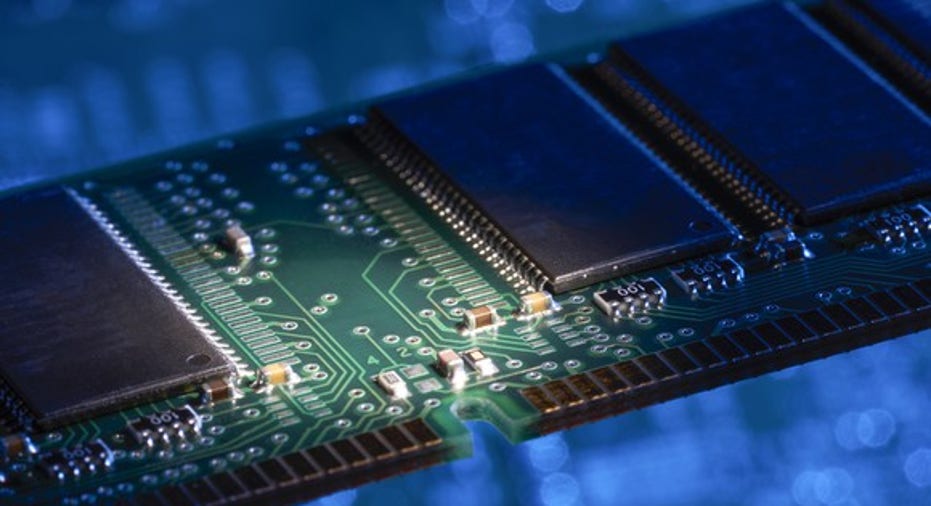3 Top Memory-Chip Stocks to Buy in 2017

Memory-chip prices rebounded inthe second half of 2016 after slumping fortwo straight years. That recovery, which is expected to continue throughout this year, is mainly attributed to tighter supplies and rising demand among device makers.
That's why many memory-chip stocks rallied over the past year. Let's look at three promising plays in this cyclical market -- Micron Technology (NASDAQ: MU), Samsung Electronics (NASDAQOTH: SSNLF), and Western Digital (NASDAQ: WDC) -- and see if they can continue rising in 2017.
Image source: Getty Images.
Micron Technology
Micron is thethird largest mobile DRAM and fourth largest NAND manufacturer inthe world. It's arguably the most straightforward play on the memory-chip market for investors, since rivals such as Samsung, Toshiba, and Western Digital generally have more diversified businesses.
Micron is currently developing next-gen memory technologies such as 3D NAND and 3DXPoint with Intel (NASDAQ: INTC), and it's scaling up by buying smaller memory-chip makers such as Inotera Memories. Micron has a pretty high enterprise value of $40 billion, but it's frequently cited as a takeover target for Intel orChina's state-backed Tsinghua Group. Tsinghua already tried to buy Micron once in 2015, but the deal was blocked by U.S. regulators on national-security concerns.
Rising memory prices are expected to boost Micron's revenue by 58% to $19.6 billion this year. Its earnings are expected to surge from $0.06 per share in 2016 to$4.28. That growth is expected to continue, with 9% sales and 20% earnings growth in 2018. Shares of Micron already surged 160% over the past 12 months, and its P/E of 50 looks high, but it's easily justified by its earnings growth.
Samsung Electronics
Samsung is the world's largest manufacturer of DRAM and NAND chips. However, it's also a heavily diversified company that sells home appliances, consumer electronics, mobile devices, display panels, and other electronic components.
Samsung's memory-chip revenues rose 10% to 37.9 trillion won($33.3 billion)in fiscal 2016, accounting for 74% of its total semiconductor revenues and 19% of the company's top line. That made the semiconductor unit Samsung's fastest-growing business and offset Note 7-related declines at its mobile business. The higher margin of the semiconductor business also enabled it to bring in 47% of its operating profits -- which offset lower margins at its mobile and consumer electronics businesses.
Unlike other leading memory-chip makers, Samsung has its own foundry, which enables it to maintain tighter control over its chips while keeping production costs low. Its production of other components such as displays also gives it bundling power with OEMs -- a strength that Micron and other smaller rivals lack.
Wall Street expects Samsung's revenue andearnings to respectively rise 11% and 46% this year, as the new Galaxy S8, higher memory-chip sales, and stabilizing display demand help it move past its Note 7 debacle andongoing corruption probe. Samsung still trades at just 11 times earnings, despite rallying nearly 50% over the past 12 months.
Western Digital
After acquiring SanDisk last year, Western Digital became the world's third largest manufacturer of NAND memory after Samsung and Toshiba. Before that, it purchased Hitachi's hard-drive unit, HGST -- which now handles mostof WD's NAND assets --as well as other flash-memory players such as Virident, STEC, VeloBit, Amplidata, and Skyera.
Image source: SanDisk.
All those moves diversified WD's business away from traditional hard disk drives, which were being displaced by flash memory-based solid-state drives. SSDs are more expensive, but they're faster, they're more power efficient, and they last longer because they didn't have any spinning platters.
WD's aggressive expansion into the NAND market paid off. Its revenue, boosted by the SanDisk deal, is expected to rise 44% this year to $18.7 billion andgrow another 2% in 2018. Its earnings are expected to jump 59% this year and 15% next year as its bigger scale reduce production costs. WD has rallied more than 80% over the past 12 months, but the stock trades at just 9 times forward earnings -- indicating that it still has room to run.
But mind the long-term risks
Some analysts have called the current spike inmemory prices the start of an "ultra-super cycle" for the industry. But that doesn't signal an all-clear for Micron, Samsung, and Western Digital just yet.
Last December, Micron warned thatstate-backed Chinese companies could flood the market with cheap memory chips in the near future, in the country's bid to build a domestic semiconductor industry. If that happens, memory prices would plummet -- which would help device makers and consumers but crush memory-chip makers. Investors should carefully weigh those risks before loading up on memory-chip stocks.
10 stocks we like better than Micron TechnologyWhen investing geniuses David and Tom Gardner have a stock tip, it can pay to listen. After all, the newsletter they have run for over a decade, Motley Fool Stock Advisor, has tripled the market.*
David and Tom just revealed what they believe are the 10 best stocks for investors to buy right now... and Micron Technology wasn't one of them! That's right -- they think these 10 stocks are even better buys.
Click here to learn about these picks!
*Stock Advisor returns as of April 3, 2017
Leo Sun has no position in any stocks mentioned. The Motley Fool owns shares of Western Digital. The Motley Fool recommends Intel. The Motley Fool has a disclosure policy.



















